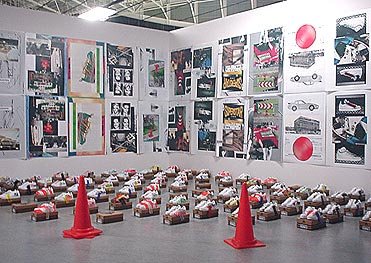Johannes Wohnseifer
dal 9/1/2008 al 8/2/2008
Segnalato da
9/1/2008
Johannes Wohnseifer
Casey Kaplan Gallery, New York
Emptiness & Violence II. The artist exhibits new paintings, sculptures and multi-media works that combine and juxtapose a wealth of references in the interest of exploring the aesthetics of politics, histories, and concepts of time. Wohnseifer highlights the contextual significance inherent in visual perception to create an installation where ideas and symbols quickly shift meaning and new relationships are formed.

Casey Kaplan is pleased to announce the third solo exhibition in New York of
Cologne-based artist Johannes Wohnseifer. Keeping with his unique practice,
Wohnseifer will exhibit new paintings, sculptures and multi-media works that
combine and juxtapose a wealth of references in the interest of exploring
the aesthetics of politics, histories, and concepts of time.
Emptiness & Violence II is a sequel to Wohnseifer's 2003 show Leere und
Gewalt (1978-2003) at the Sprengel Museum Hanover, Germany. There, his
installation made connections between specific histories surrounding the
institution and the city of Hanover with references to the 1978 Lufthansa
Cargo heist at JFK airport and Martin Scorcese's 1990 film Goodfellas. Each
element on view addressed the notion of time and relationships of events to
one another, past, present, or future; a theme that carries into
Wohnseifer¹s new body of work.
The new exhibition begins with the eponymous work "Emptiness and Violence,"
a series of 13 found landscape paintings made in Germany between the years
1933 and 1945. Each banal painting was made by an amateur and/or unknown
artist during that time. Installed chronologically under red-filtering
Plexiglas, the works form a scenic panorama of Nazi Germany.
Also on view, twelve identical black and white silk screens that depict an
image appropriated from a psychology textbook published in the former German
Democratic Republic. Each piece represents one calendar month, indicated by
multiple prismatic forms. The same shape appears in the aluminum-based work
Poster Painting, where the secret burial chamber of the Cheops Pyramid hints
at the structure of this exhibition, and its deceptive paths.
The sense of timelessness in these works is contrasted with a convergence of
histories in a communicative bar sculpture made from carbon and zebra wood
that is illuminated by three hanging lamps symbolizing the Ethiopian flag
colors: red, gold and gr
een. Informing this piece are works inspired by
specific moments such as the 1930 Time magazine cover featuring Emperor of
Ethiopia Haile Selassie as ³The King of Kings;² German artist Blinky
Palermo's series of aluminum-based paintings entitled To the people of New
York City, 1976-77; current board members at The Museum of Modern Art, New
York and The Museum of Contemporary Art, Los Angeles; and the 1963
photograph of Marcel Duchamp playing chess at the Pasadena Art Museum with
the nude model Eve Babitz.
By combining worlds of fact and fiction, precise references and oblique
allusions, Wohnseifer highlights the contextual significance inherent in
visual perception to create an installation where ideas and symbols quickly
shift meaning and new relationships are formed.
In 2008, Wohnseifer will have one-person exhibitions at Galerie Gisela
Capitain, Cologne, Germany and Sammlung Haubrok, Berlin, Germany. The
artist's solo show Kleenex Mathematics, took place at Presentation House
Gallery, Vancouver, Canada in 2007. Recent group exhibitions include
Bodypoliticx, Witte de With, Rotterdam, Netherlands; Images of Society,
Contemporary Painting, at Kunstverein, Hamburg, Germany; "Auto/Emotion:
Autobiography, Emotion, and Self-Fashioning," The Power Plant, Toronto,
Canada; and "Second Moscow Biennale for Contemporary Art, Moscow, Russia.
Opening Thursday, January 10th 6-8PM
Casey Kaplan Gallery
525 West 21st Street - New York
Free admission



